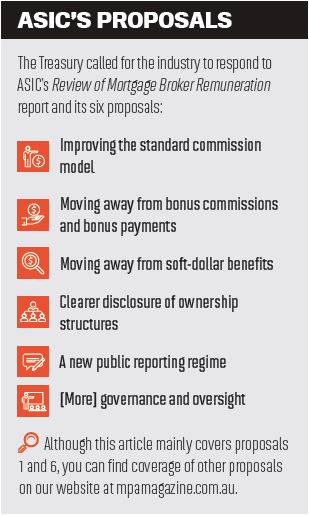Brokers and bankers have finally given the Treasury their proposals for the future of commissions and begun an ambitious process of industry self-regulation, writes MPA editor Sam Richardson

Brokers and bankers have finally given the Treasury their proposals for the future of commissions and begun an ambitious process of industry self-regulation, writes MPA editor Sam Richardson
The final day of June was no ordinary day for broking; it was the day the industry had to finally put its cards on the table. Commissions have been the topic of endless bluster over the past two years, in the form of angry press releases, reassuring speeches and drawn-out reviews, but the closing of the
Treasury’s consultation on 30 June meant that industry stakeholders had to present to regulators their final views on the future of broker remuneration.
Stakeholders responded to six proposals made by ASIC, the first of which – ‘Improving the standard commission model’ – has been the subject of most interest. Yet the consultation process had another purpose: gauging whether the industry is capable of orderly self-regulation, or whether new rules will have to be imposed by ASIC.
Not all stakeholders were willing to share their Treasury submissions with MPA. The MFAA, CHOICE, Connective and AFG gave us their full submissions. The Australian Bankers Association and the FBAA agreed to be exclusively interviewed about their submissions. The Customer Owned Banking Association did not respond to repeated requests for comment.
Improving the standard commission model
The ASIC Review of Mortgage Broker Remuneration report called for remuneration to be reformed “so that brokers are not incentivised purely by the size of the loan”, suggesting that remuneration could be determined by other factors such as LVR.
Industry responses sit along a spectrum. At one end is Connective, whose submission considers various options and concludes: “Connective does not support any of these alternatives as they are unworkable and each have the potential to lead to other bad consumer outcomes.”
The MFAA says commission ‘pivoting’ on LVR (higher percentage of loan size for lower- LVR loans) is “potentially suitable [but] with unintended consequences”. Both the MFAA and AFG look favourably on upfront commission that is based on the drawdown rather than the total approved amount, and tentatively support linking commissions to loan quality.
The ABA told MPA that “we don’t think that the concept of upfront and trail should be abandoned” but, repeating the conclusion of the Sedgwick review, added that “we do believe that the standard commission model will need to be delinked from loan size”. The ABA promised, however, to work with the industry to decide the exact figures of the new model.
Most critical of the status quo was an alliance of CHOICE, Consumer Action, Financial Counselling Australia and the Financial Rights Legal Centre. Their combined submission called for trail commissions to be removed “as they offer no benefit to consumers”, with upfront replaced by fixed fees and all commissions uncoupled from loan size.

“ASIC and the Treasury have been very clear with all the meetings that we’ve had that they’ll give the industry a chance to self-regulate” Mike Felton, MFAA
Self-regulation
If remuneration does change, its new structure may not be decided by ASIC but instead by the ‘combined industry forum’.
Three months ago, with the Sedgwick review calling for changes to broker commissions and industry associations feuding with each other, a combined forum of the MFAA, the FBAA, the ABA and COBA would have seemed laughable, but that’s exactly what took place in June, followed by another forum meeting in July.
The forum’s initial aim is to come up with an industry response to ASIC, which some have taken to mean self-regulation. MFAA CEO Mike Felton says, “ASIC and the Treasury have been very clear with all the meetings that we’ve had that they’ll give the industry a chance to self-regulate … if we don’t, it will be taken out of our hands and done for us or done to us.”
Self-regulation was appealing “in principle”, the ABA told MPA. They explained that the forum’s “initial objective is providing a solution to the government for them to consider and, depending on the government’s response and acceptance of the solution, we would look at self-regulatory mechanism to implement it”.

The combined industry forum will take months (a timeline was drafted in July), which Felton believes regulators will allow. The forum does, however, face a number of other challenges to reaching a solution.
Australia’s laws against monopolies mean participants have to be above suspicion of commercial collusion, with lawyers always present and the forum closed to the public, although some brokers and aggregators have been invited to take part.
“We do believe that the standard commission model will need to be delinked from loan size” Australian Bankers Association
Another risk is that forum participants may take unilateral action, undermining the process. The ABA has promised that “in terms of activity outside the forum, the ABA’s energy is invested in pursuing the objectives of the forum”. Nevertheless, “our member banks are also committed to implementing the recommendations of the [Sedgwick] review”, with implementation being completed by 2020, unless the forum can negotiate an alternative approach.
Consumer advocate groups have demanded to be included in the forum or, failing that, for regulators or the government to lead reform. “Reform must be focused on what’s best for consumers, not what works for brokers, aggregators or lenders,” said the submission, “Several recommendations from the review leave solutions to widespread industry problems in the hands of industry. This is not good enough.”
The ABA indicated to MPA that the forum had always planned to set up a channel to address consumer views, meaning the strong views of CHOICE and others regarding broker remuneration will need to be addressed.
Finally, the industry’s faith in self-regulation may itself be premature.
“I question whether it’s the right terminology,” FBAA CEO Peter White told MPA. “It is impossible for us to self-regulate as we are regulated by ASIC.”
Ultimately, ASIC and the Treasury will have to approve the combined industry forum’s suggestions, and White doesn’t believe ASIC will compromise just because the industry has other ideas. Australia’s regulators are happy for the industry to draft rules “so long as they can tick the box: if they don’t agree, the box doesn’t get ticked”.



